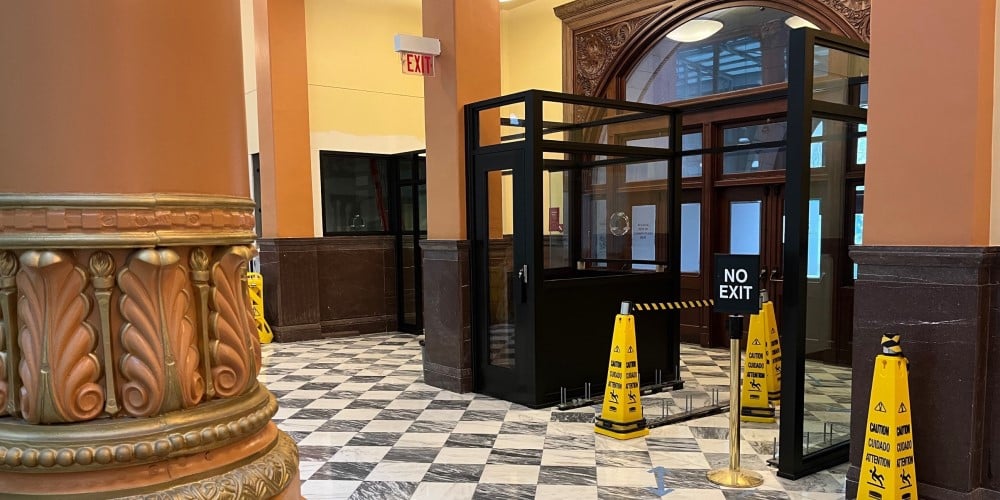Today, the access control vestibule and secure entryway is now a key component of safety and security in many public buildings. It’s familiar enough that many are surprised to realize that public buildings have been regularly adding such security enhancements for less than ten years.
"The access control vestibule is definitely a relatively new development in building security, here in the United States," Jim Richards explains. Jim is the president and CEO of Total Security Solutions and he has decades of experience in ballistic security for buildings.
"Over the last five years or so [secure entry vestibules have] basically become a standard feature in schools, courthouses, and municipal buildings. But we only did the first custom access control vestibule retrofit around 2013. At that time, it was a very school-specific solution, in response to how attacks had changed. Unfortunately, that kind of attack has only become more prevalent. So we've seen increasing interest in these access control vestibule renovations, and access control in general: make it harder to get into that building, then limit where someone can go and how much harm they can do.”
Elements of an Access Control Vestibule to Prevent Unauthorized Access
Even today, most access control vestibule projects are renovations of existing vestibules. Just as the existing security vestibule controls the flow of weather into the building, the access control vestibule modifies that entryway to control the flow of people into the building.
At its most basic, an access control vestibule has three core elements:
- Bullet-resistant glazing and frames, usually replacing a pre-existing non-rated window wall or curtain wall;
- Bullet-resistant access doors equipped with electric strikes (and, again, usually replacing the pre-existing doors);
- A wall-mounted transaction window where visitors check in and, if appropriate, can be buzzed through the access door. In some facilities, facial recognition or biometric scanning systems are also integrated at this point to support advanced access control protocols.
Depending on the structure of the walls surrounding the entryway, it may also call for some reinforcement with ballistic fiberglass. Although a secure entryway can be made to any UL protection level, most are currently being built to provide Level 3 or Level 4 protection. (A Level 3 system will stop several shots from any common handgun, while a Level 4 system will do likewise, in addition to stopping bullets from high-powered rifles.)

But not every secured entryway renovation project uses the existing access control vestibule. Owing to experience securing government buildings at every level (from federal facilities to local utility offices), TSS is uniquely suited to finding ways to compartmentalize and secure an entryway without compromising building aesthetics or day-to-day functionality.
Factors to Consider While Planning a Ballistic Entryway
When looking to secure an entryway, organizations need to consider three key factors—only one of which is obviously security related.
What Is the Threat Level and Threat Profile?
This includes both the UL protection level for the ballistic materials (as per the chart below) and also explicit threats your organization, or organizations like yours, have received.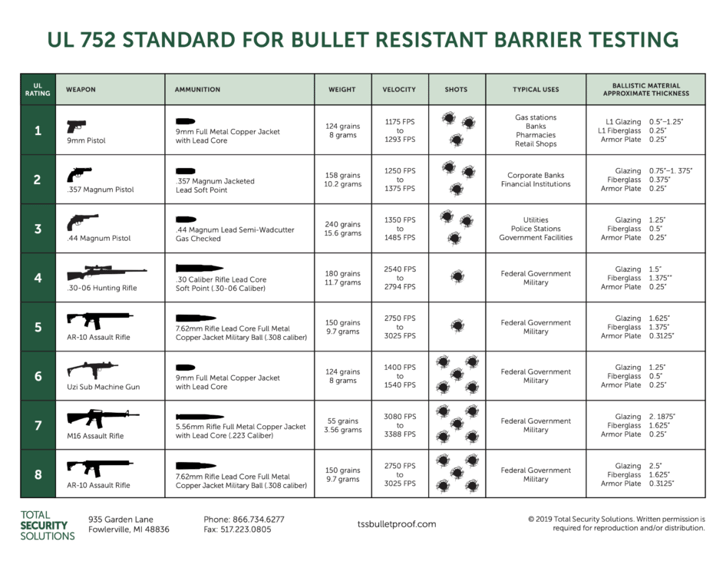
"Some organizations," Jim Richards points out, "come to us because they've received one or more actual threats. Obviously, they've pursued this with law enforcement. But it may not occur to them to actually share them with their bulletproof entryway designer. If you've received several emails threatening to blow up your building, you probably want to consider an entryway that has a blast- or forced-entry rating. You also want to consider how you're handling packages, visitors with backpacks, and so on."
In addition to experience with complete custom ballistic barrier systems, TSS has also designed and fabricated countless custom secure package passing solutions for their clients.
What Building Use Patterns Should Factor into Your Security System Choices?
From a security standpoint, you want your entryway to be a bottleneck that every visitor must pass through. Incorporating two sets of interlocking doors helps maintain that controlled flow. The first door opens into a buffer zone, which limits immediate access and creates a pause point for screening or authorization before entry into the secured interior.
But you want that bottleneck to flow efficiently, not become a chokepoint that both frustrates daily operations and creates a crowd of individuals vulnerable to attack as they wait to enter a secure area.
Some buildings, like schools, have extremely predictable daily "unidirectional" traffic patterns, with most students arriving and leaving during a narrow time window. Other buildings have steady streams of visitors each day or weekly/monthly/seasonal ebbs and surges.
But visitors entering and leaving the building are only one facet of the flow through the entryway. How often does a delivery have to come through the visitor entry point? For that matter, are there alternate delivery points for different kinds of deliveries? For example, in many buildings, USPS/UPS/FedEx/couriers deliver items at the front check-in, while bulk maintenance-related or cafeteria deliveries come through a second door: a rear loading dock. How are these alternate delivery points kept secure? Do existing security systems in those areas need an upgrade, perhaps as simple as swapping in a new buzz-thru door and adding a security camera as another layer of protection?
The Intersection of Infrastructure, Building Amenities, and Systems with Security Measures
In many cases, the biggest challenge to adding an access control vestibule or secured entryway isn't posed by the threat or people, but by the building itself. For example, a secured entryway renovation can wreak havoc on building HVAC. This is especially the case with regions where there are regularly very wide temperature or humidity differences between indoors and outdoors (i.e., North Dakota in the winter or Florida in the summer).
"Out in the Dakotas," Jim points out, "in the summer it can be in the 90s, and in the winter it could be 30 below. We've seen barrier systems there—and even just standard windows—where that isn't correctly accounted for and they get frost on the frames in the winter and condensation puddling in the summer. Of course, it isn't always possible to 100% eliminate that. Nature is nature. But with proper design and using the right materials, you can make a huge, huge improvement. Meanwhile, if you don't design with these factors in mind, you can make a huge, huge mess."
Each unique building also provides unique opportunities. Existing features—like brick-walled security vestibules, long entry corridors, and existing office layouts—can create opportunities that experienced bulletproofing companies can capitalize on.
Creating Custom Secure Entryways As Your First Line of Defense
In many cases, the custom entryway or access control vestibule project design is largely guided by the building. This secure entryway upgrade for a California police department is a perfect example. By converting the existing reception area into a ballistically secure "teller line" set of transaction windows and adding a buzz-thru bulletproof door with wood veneer, TSS was able to substantially increase the building's level of security while taking advantage of certain inherently bullet-resistant architectural elements (e.g., existing brick walls). 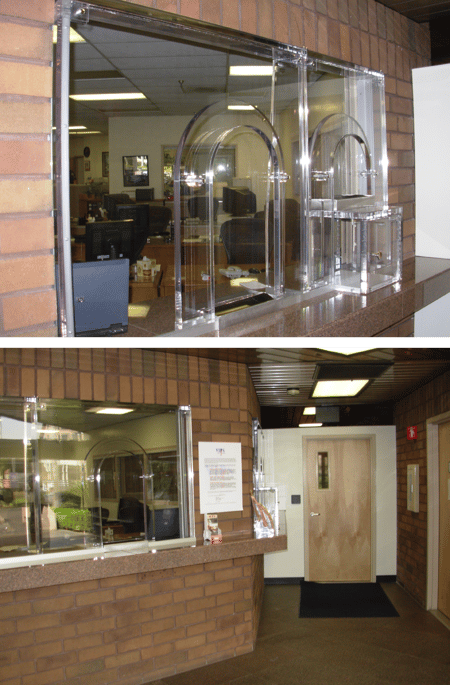
Meanwhile, this security upgrade for the historic Conrad B. Duberstein U.S. Bankruptcy Courthouse and General Post Office in Brooklyn, NY offered a different set of challenges and opportunities. The expansive lobby had plenty of room for TSS to add an entirely new multi-lane entryway—in effect making the entire area between the historic doors and the checkpoint a controlled access vestibule.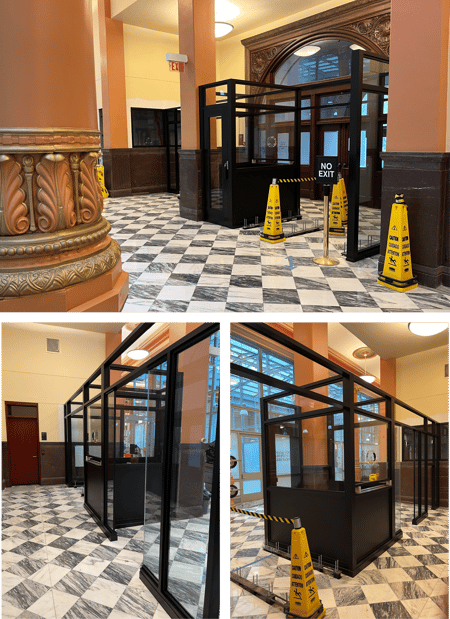
But the historically significant architecture and interior—which had been extensively restored by the GSA in the early 2000s—required special attention. The detailed photo below shows one of the many precision-cut ballistic "fillers" TSS created so that there would be no gap between the complex profile of the original marble wainscotting and the new ballistic barrier framing.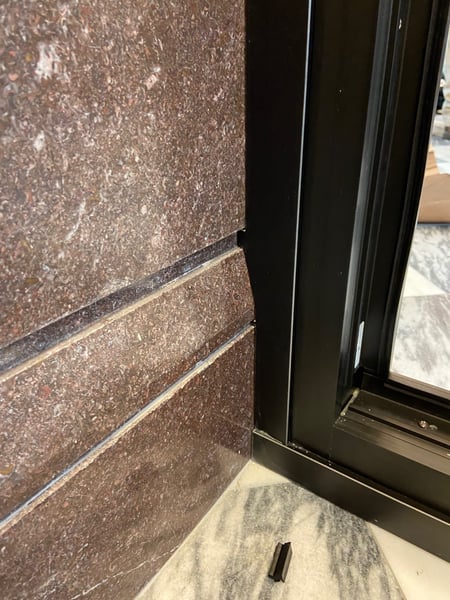
The fit is so tight and precise that, even prior to caulking, an ant could hardly slip through the gap between the aluminum frame and the marble.
Precision, Accuracy, and Effective Communication for Optimal Custom Security
"I like details like this,” Jim explains, “because it really brings together everything I like about our teams: precise and accurate measurements on-site, good communication between teams, and having the right machines and the right people here in Fowlerville to fabricate pieces to that precision. People ask if there was a lot of back and forth and trimming and shaving to get that fit just right, and the answer is 'No.' That’s because no one working on those pieces said 'Oh, that's good enough, that's close enough.' The linchpin is that this is our expectation about how something should look, and everyone on the team makes it their business to make that happen.”
Do you need to add an access control vestibule or secure an entryway without making your building feel like a fortress or prison? Contact our ballistic security experts to discuss your needs and concerns or to get started with a specific project. From schools and office buildings to government spaces and data centers, we have the expertise and experience to keep your people and your facility safe.
